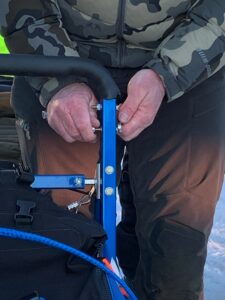On the surface, it may seem that there aren’t a lot of commonalities between dog sleds and spacecraft. After all, a sled is a structure designed for teams of dogs to pull loads across ice and snow. Spacecraft have many components including rocket engines, service modules housing life-support mechanisms, and astronaut living quarters. But there’s more in common than you might think, especially if we dig deeper into some big ideas: Invention, Innovation, and Design.

An open sled with all the mandatory gear. Photo: Terrie Hanke
Invention—why were these amazing vehicles invented? I like to think that both dog sleds and spacecraft were invented to fulfill the human need to travel and explore. We know that the first ever human spacecraft was Vostok I, carrying Yuri Gagarin into space on April 12, 1961. In contrast, the origin of the first dog sled is lost in the mists of time. The earliest evidence of a dog sled is from about 1000 A.D., but historians are confident that people living in the Arctic have been using sleds for thousands of years. As the science of rocketry advanced after World War II, it was inevitable that a human would fly into space. It’s crazy to think that the first human space flight happened only sixty-three years ago—12 years before the first Iditarod.

Tightening bolts on an aluminum sled. Photo: K. Newmyer
Innovation is the star of both racing dog sleds and space craft. Since the Apollo program, thousands of innovations have fueled the advance of spaceflight, including creating new materials. People have also made many improvements to the materials of dog sleds over the years. Most commonly constructed of lightweight wood, sleds are now also made from aluminum, carbon fiber, and plastics. I was excited to find a video by Cody Strathe posted by 2019 Teacher on the Trail Brian Hickox, in which Cody explains the components of his sled. Behind him is what looks like the ultimate dog sled laboratory! I suspect a NASA engineer would be just as at home in Cody’s workshop as in a clean room.
Lastly, let’s consider the idea of Design. Both vehicles are perfectly designed for their intended purpose. Racing sleds are small, light and easily maneuverable. Loads ride comfortably on top of ice and snow on stanchions built above the runners. Each sled has a brush bow to deflect low vegetation and snow piles, mechanisms for the musher to control and slow the sled, and a sled bag for carrying cargo. Spacecraft are also perfectly designed to protect astronauts as they speed away from Earth’s gravity, and then to perform essential functions—carry loads, provide a safe environment to maintain life, and protect itself on re-entry into Earth’s atmosphere.

Brent Sass’s streamlined sled ready for the 2023 Ceremonial Start. Photo: K. Newmyer
Thinking about big ideas is a concept I use frequently in my classroom. When we examine big ideas from different kinds of content—such as dog sleds and spacecraft—we find that we can understand each one better. This makes for a rich and fun learning experience.
What big ideas do you use to connect or contrast concepts in your classroom? Email me at emailtheteacher@iditarod.com.


